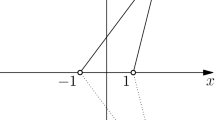Abstract
In recent previous work, the authors proposed a new approach extending the framework of statistical mechanics to reparametrization-invariant systems with no additional gauges. In this paper, the approach is generalized to systems defined by more than one Hamiltonian constraint (multi-fingered time). We show how well-known features as the Ehrenfest–Tolman effect and the Jüttner distribution for the relativistic gas can be consistently recovered from a covariant approach in the multi-fingered framework. Eventually, the crucial role played by the interaction in the definition of a global notion of equilibrium is discussed.


Similar content being viewed by others
Notes
If \(C^b\) is not the only conserved quantity for \(\mathcal {S}^b\), the statistical state should include additional “\(\delta\)-functions”.
The split \(C= C^a+C^b=0\) determines a foliation of the presymplectic surface
$$\begin{aligned} \varSigma = \bigsqcup _{I^a+I^b=0} \varSigma ^a_{I^a} \times \varSigma ^b_{I^b}, \end{aligned}$$where \(X^\alpha = \bigsqcup _{I^\alpha } \varSigma ^\alpha _{I^\alpha }\) and \(I^\alpha\) is the value of \(C^\alpha\) on the leave. Each \(\left( \varSigma ^\alpha _{I^\alpha }, \omega _{X^\alpha }|_{\varSigma ^\alpha _{I^\alpha }} \right)\) is the presymplectic space that would describe the subsystem \(\mathcal {S}^\alpha\) if it was isolated. The existence of the split implies the existence of the conserved quantity \(I=I^b=-I^a\), defined up to clock reparametrization \(I \rightarrow f(I)\). See cf. [8] for full details.
This fact was actually glimpsed by Einstein [12], even before General Relativity was completed!
So that the local gravitational field is approximately uniform.
V can be thought as an effective potential coming from a (Lorentz invariant) interaction with an (relativistic) ambient field.
In the absence of an external potential, the total 4-momentum is conserved, insuring Lorentz covariance of the statistical state.
References
Bardeen, J.M., Carter, B., Hawking, S.W.: The four laws of black hole mechanics. Commun. Math. Phys. 31(2), 161–170 (1973)
Hawking, S.W.: Black hole explosions? Nature 248(5443), 30–31 (1974)
Bekenstein, J.D.: Black holes and entropy. Phys. Rev. D 7, 2333–2346 (1973)
Jacobson, T.: Thermodynamics of spacetime: the Einstein equation of state. Phys. Rev. Lett. 75, 1260–1263 (1995)
Verlinde, E.: On the origin of gravity and the laws of Newton. J. High Energy Phys. 2011(4), 1–27 (2011)
Kuchař, K.V.: Time and interpretations of quantum gravity. In: G. Kunstatter, D.E. Vincent, and J.G. Williams (eds.), Proceedings of the 4th Canadian Conference on General Relativity and Relativistic Astrophysics, p. 211 (1992)
Rovelli, C.: Analysis of the distinct meanings of the notion of time, in different physical theories. Il Nuovo Cimento B Series 11 110(1), 81–93 (1995)
Chirco, G., Josset, T., Rovelli, C.: Statistical mechanics of reparametrization-invariant systems. It takes three to tango. Class. Quant. Gravity 33(4), 045005 (2016)
Dirac, P. A. M.: Generalized hamiltonian mechanics. Can. J. Maths. Phys. 2 (1950)
Rovelli, C.: Quantum Gravity. Cambridge University Press, Cambridge (2004)
Tolman, R.: On the weight of heat and thermal equilibrium in general relativity. Phys. Rev. 35, 904–924 (1930)
Einstein, A.: Zur theorie des statischen gravitationsfeldes. Ann. Phys. 38, 443–458 (1912)
Tolman, R., Ehrenfest, P.: Temperature equilibrium in a static gravitational field. Phys. Rev. 36, 1791–1798 (1930)
Balazs, N., Dawson, J.: On thermodynamic equilibrium in a gravitational field. Physica 31(2), 222–232 (1965)
Ebert, R., Göbel, R.: Carnot cycles in general relativity. Gen. Relat. Gravit. 4(5), 375–386 (1973)
Rovelli, C., Smerlak, M.: Thermal time and the Tolman–Ehrenfest effect: temperature as the speed of time. Class. Quant. Gravit. 28, 075007 (2011)
Haggard, H.M., Rovelli, C.: Death and resurrection of the zeroth principle of thermodynamics. Phys. Rev. D 87, 084001 (2013)
Jüttner, F.: Das maxwellsche gesetz der geschwindigkeitsverteilung in der relativtheorie. Ann. Phys. 339(5), 856–882 (1911)
Cubero, D., Casado-Pascual, J., Dunkel, J., Talkner, P., Hänggi, P.: Thermal equilibrium and statistical thermometers in special relativity. Phys. Rev. Lett. 99, 170601 (2007)
Rovelli, C.: Why Gauge? Found. Phys. 44, 91–104 (2014)
Chirco, G., Haggard, H.M., Rovelli, C.: Coupling and thermal equilibrium in general-covariant systems. Phys. Rev. D 88, 084027 (2013)
Acknowledgements
The authors are grateful to Carlo Rovelli for careful reading of the draft and useful comments, and to the Quantum Gravity Group at the Centre de Physique Théorique de Luminy, where this project was started. G.C. is grateful to Daniele Oriti and Hermann Nicolai for the support at the Max Planck Institute for Gravitational Physics in Potsdam, where the work was partially completed.
Author information
Authors and Affiliations
Corresponding author
Additional information
Publisher's Note
Springer Nature remains neutral with regard to jurisdictional claims in published maps and institutional affiliations.
Rights and permissions
About this article
Cite this article
Chirco, G., Josset, T. Statistical Mechanics of Covariant Systems with Multi-fingered Time. Found Phys 51, 3 (2021). https://doi.org/10.1007/s10701-021-00406-3
Received:
Accepted:
Published:
DOI: https://doi.org/10.1007/s10701-021-00406-3




